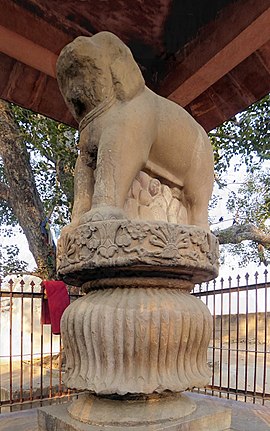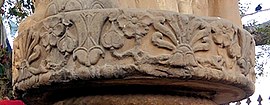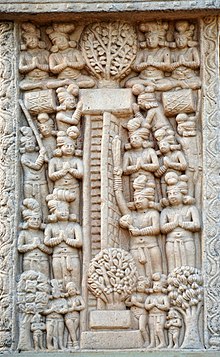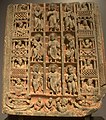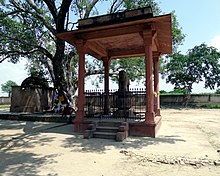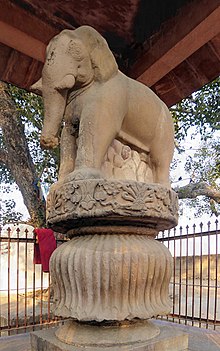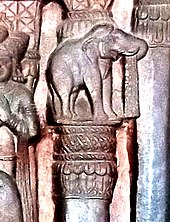
The early Buddhist schools are those schools into which the Buddhist monastic saṅgha split early in the history of Buddhism. The divisions were originally due to differences in Vinaya and later also due to doctrinal differences and geographical separation of groups of monks. The original saṅgha split into the first early schools during or after the reign of Aśoka. Later, these first early schools were further divided into schools such as the Sarvāstivādins, the Dharmaguptakas, and the Vibhajyavāda, and ended up numbering 18 or 20 schools according to traditional accounts.
The Aṭṭhakavagga and the Pārāyanavagga are two small collections of suttas within the Pāli Canon of Theravada Buddhism. They are among the earliest existing Buddhist literature, and place considerable emphasis on the rejection of, or non-attachment to, all views.

The Sutta Piṭaka is the second of the three divisions of the Tripiṭaka, the definitive canonical collection of scripture of Theravada Buddhism. The other two parts of the Tripiṭaka are the Vinaya Piṭaka and the Abhidhamma Piṭaka. The Sutta Pitaka contains more than 10,000 suttas (teachings) attributed to the Buddha or his close companions.
The Khuddaka Nikāya is the last of the five Nikāyas, or collections, in the Sutta Pitaka, which is one of the "three baskets" that compose the Pali Tipitaka, the sacred scriptures of Theravada Buddhism. This nikaya consists of fifteen (Thailand), fifteen, or eighteen books (Burma) in different editions on various topics attributed to Gautama Buddha and his chief disciples.

Śāriputra was one of the top disciples of the Buddha. He is considered the first of the Buddha's two chief male disciples, together with Maudgalyāyana. Śāriputra had a key leadership role in the ministry of the Buddha and is considered in many Buddhist schools to have been important in the development of the Buddhist Abhidharma. He frequently appears in Mahayana sutras, and in some sutras, is used as a counterpoint to represent the Hinayana school of Buddhism.

The Abhidhamma Piṭaka is the third of the three divisions of the Tripiṭaka, the definitive canonical collection of scripture of Theravada Buddhism. The other two parts of the Tripiṭaka are the Vinaya Piṭaka and the Sutta Piṭaka.

Pali literature is concerned mainly with Theravada Buddhism, of which Pali is the traditional language. The earliest and most important Pali literature constitutes the Pāli Canon, the authoritative scriptures of Theravada school.

The Sutta Nipāta is a Buddhist scripture, a sutta collection in the Khuddaka Nikaya, part of the Sutta Pitaka of the Pali Canon of Theravada Buddhism. Sutta Nipata is a collection of discourses of Buddha. It is part of an early corpus of Buddhist literature. Chalmers explains that sutta means a consecutive thread of teaching and Oldenberg explained that nipata denotes a small collection.
Aṭṭhakathā refers to Pali-language Theravadin Buddhist commentaries to the canonical Theravadin Tipitaka. These commentaries give the traditional interpretations of the scriptures. The major commentaries were based on earlier ones, now lost, in Prakrit and Sinhala, which were written down at the same time as the Canon, in the last century BCE. Some material in the commentaries is found in canonical texts of other schools of Buddhism, suggesting an early common source.
Khema was a Buddhist bhikkhuni, or nun, who was one of the top female disciples of the Buddha. She is considered the first of the Buddha's two chief female disciples, along with Uppalavanna. Khema was born into the royal family of the ancient Kingdom of Madra, and was the wife of King Bimbisara of the ancient Indian kingdom of Magadha. Khema was convinced to visit the Buddha by her husband, who hired poets to sing about the beauty of the monastery he was staying at to her. She attained enlightenment as a laywoman while listening to one of the Buddha's sermons, considered a rare feat in Buddhist texts. Following her attainment, Khema entered the monastic life under the Buddha as a bhikkhuni. According to Buddhist tradition, the Buddha declared her his female disciple foremost in wisdom. Her male counterpart was Sariputta.

Uppalavanna was a Buddhist bhikkhuni, or nun, who was considered one of the top female disciples of the Buddha. She is considered the second of the Buddha's two chief female disciples, along with Khema. She was given the name Uppalavanna, meaning "color of a blue water lily", at birth due to the bluish color of her skin.

The miracles of Gautama Buddha refers to supernatural feats and abilities attributed to Gautama Buddha by the Buddhist scriptures. The feats are mostly attributed to supranormal powers gained through meditation, rather than divine miracles. Supranormal powers the historic Buddha was said to have possessed and exercised include the six higher knowledges (abhiññā): psychic abilities (iddhi-vidhā), clairaudience (dibba-sota), telepathy (ceto-pariya), recollection of one's own past lives (pubbe-nivāsanussati), seeing the past lives and rebirths of others (dibba-cakkhu), and the extinction of mental intoxicants (āsavakkhaya). Miracles found in Mahayana sutras generally play a more direct role in illustrating certain doctrines than miracles found in non-Mahayana Buddhist texts. Apart from texts, several of the miracles are often shown in scenes of the life of Buddha in art.

The Petavatthu is a Theravada Buddhist scripture, included in the Minor Collection of the Pali Canon's Sutta Pitaka. It ostensibly reports stories about and conversations among the Buddha and his disciples, and it dates to about 300 BC at the earliest. It is composed of 51 verse narratives describing specifically how the effects of bad acts can lead to rebirth into the unhappy world of petas (ghosts) in the doctrine of kamma. More importantly, it details how meritorious actions by the living can benefit such suffering beings.

The Niddesa is a Buddhist scripture, part of the Pali Canon of Theravada Buddhism. It is included in the Sutta Pitaka's Khuddaka Nikaya. It is in the form of a commentary on parts of the Suttanipata. The tradition ascribes it to the Buddha's disciple Sariputta. It is divided into two parts:

Nigrodhārāma was a Sangharama with a Banyan grove near Kapilavastu, where a residence was provided for the Buddha when he visited the city in the first year after his Enlightenment. It belonged to a Sākyan named Nigrodha, the monk who made Ashoka, the Mauryan Emperor a Buddhist; who gave it to the Monastic Order. The Nigrodharama is located at the site of the modern Kudan village, about six kilometres south of Tilaurakot, the citadel of Kapilavastu. The precise location of Nigrodharama is at the following coordinates: 27.528186°N 83.040757°E.
The sub-commentaries are primarily commentaries on the commentaries on the Pali Canon of Theravada Buddhism, written in Sri Lanka. This literature continues the commentaries' development of the traditional interpretation of the scriptures. These sub-commentaries were begun during the reign of Parākramabāhu I (1123–1186) under prominent Sri Lankan scholars such as Sāriputta Thera, Mahākassapa Thera of Dimbulagala Vihāra and Moggallāna Thera.
The Maṅgala Sutta is a discourse of Gautama Buddha on the subject of 'blessings'. In this discourse, Gautama Buddha describes 'blessings' that are wholesome personal pursuits or attainments, identified in a progressive manner from the mundane to the ultimate spiritual goal. In Sri Lanka, this sutta considered to be part of "Maha Pirith".

The Pāli Canon is the standard collection of scriptures in the Theravada Buddhist tradition, as preserved in the Pāli language. It is the most complete extant early Buddhist canon. It derives mainly from the Tamrashatiya school.
Bhāṇaka were Buddhist monks who specialized in the memorization and recitation of a specific collection of texts within the Buddhist canon. Lineages of bhāṇakas were responsible for preserving and transmitting the teachings of the Buddha until the canon was committed to writing in the 1st century BC, and declined as the oral transmission of early Buddhism was replaced by writing.
